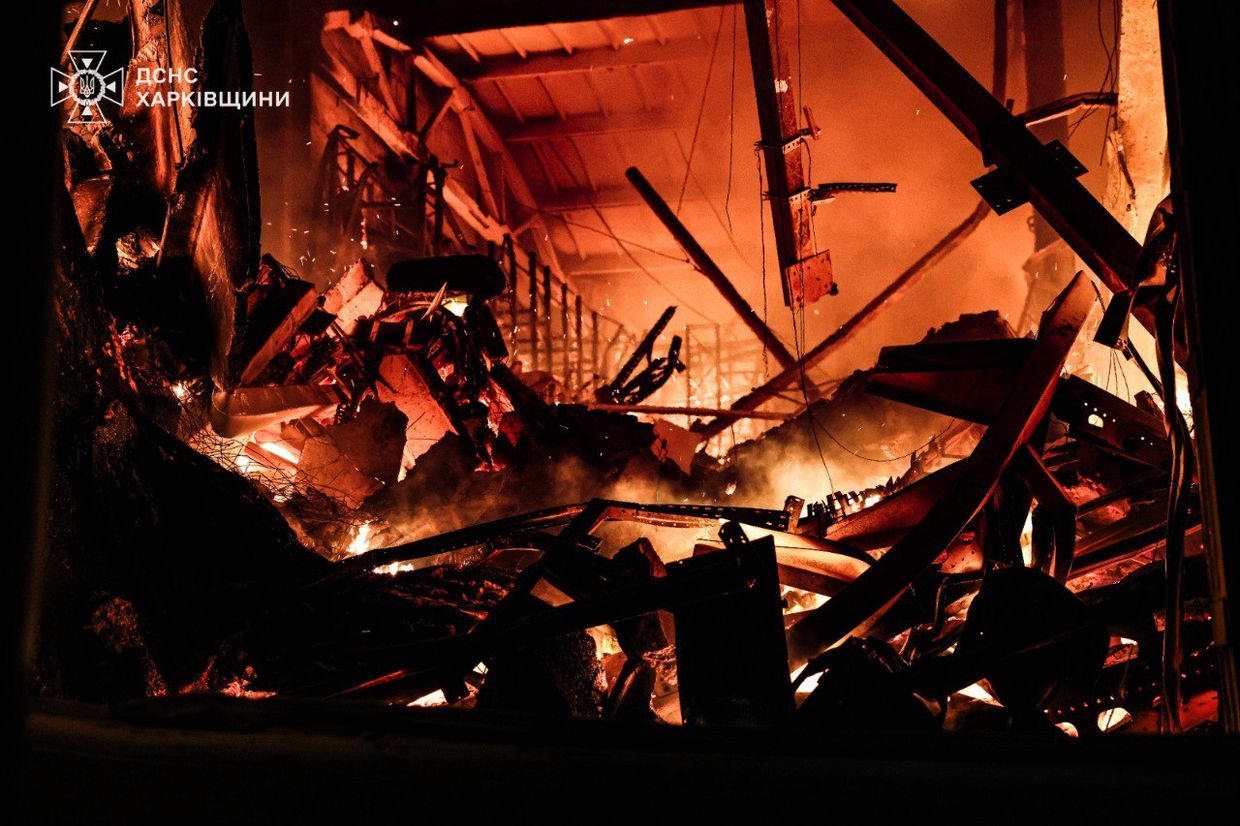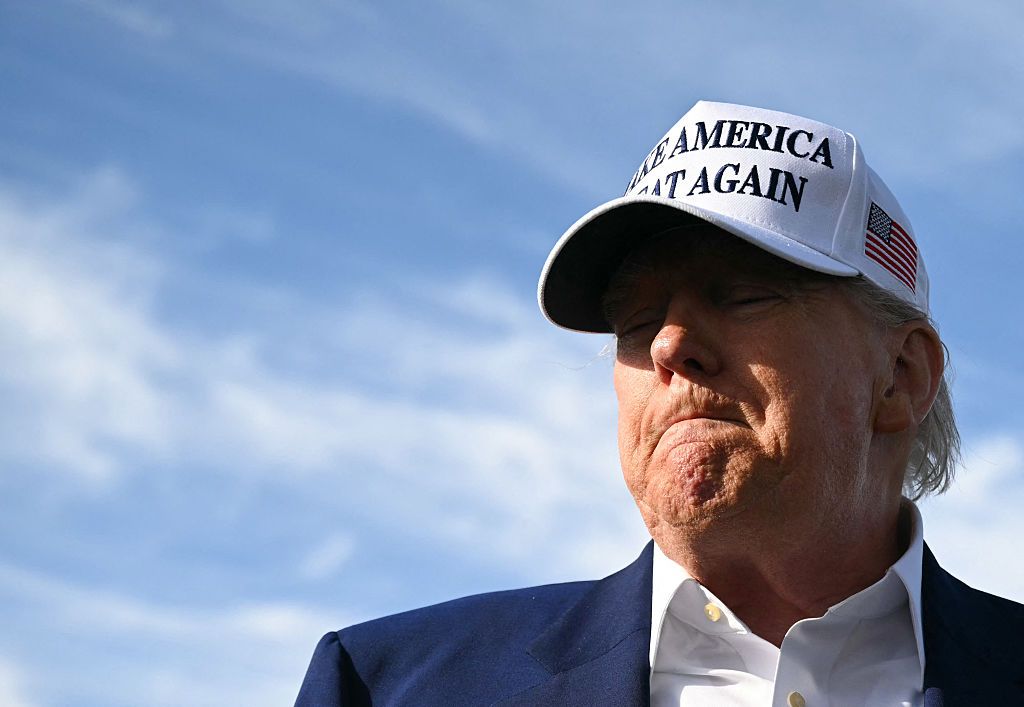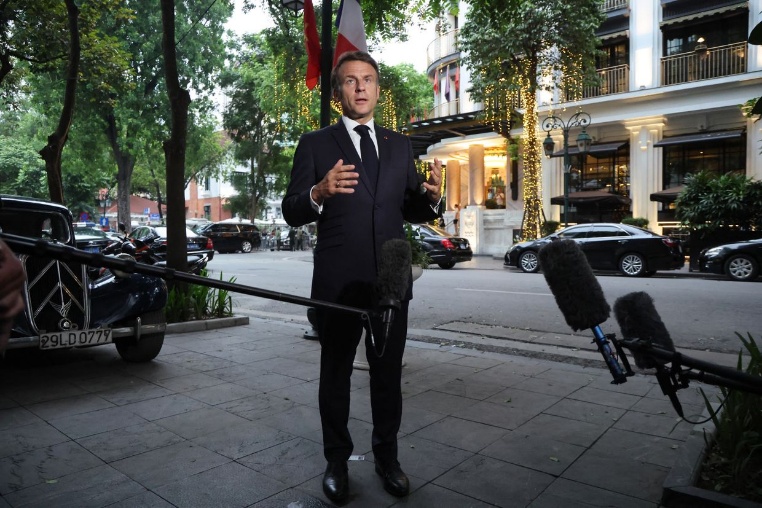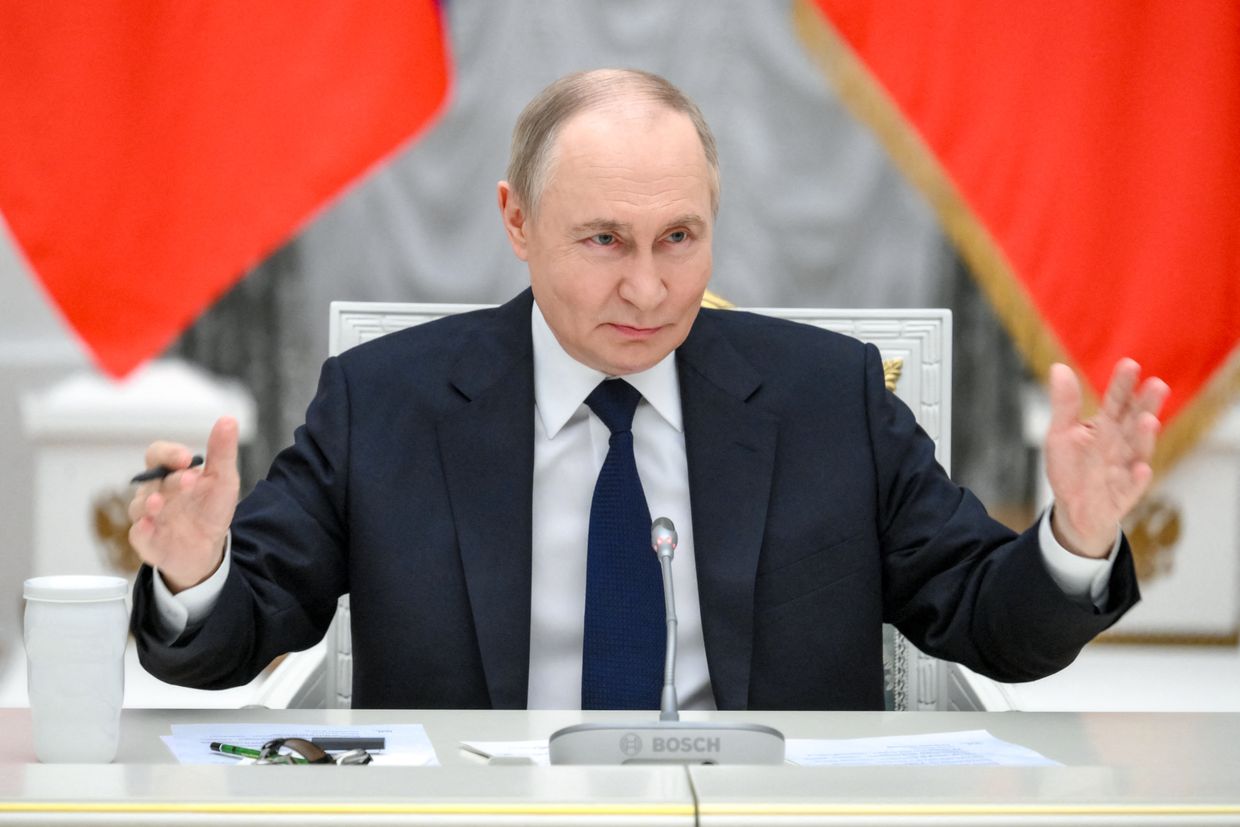As Trump Calls Putin “Absolutely Crazy” and Kremlin Scrambles Buffer Zones, Ukraine’s Intelligence Warns of Moscow’s 2-4 Year Plan to Attack Europe
Summary of the Day – May 26, 2025
Russia launched its most massive drone assault of the war—355 Shaheds and decoys alongside nine cruise missiles—in a three-night crescendo of terror that left six dead and 24 wounded across Ukraine. This record-breaking barrage prompted an unprecedented rebuke from Donald Trump, who declared Putin had gone “absolutely crazy,” while Emmanuel Macron observed that Trump finally realizes “Putin lied to him” about wanting peace. As Ukraine completed its prisoner exchange and secured release of POWs from 46 units previously blocked by Russia, Moscow seized four border villages in Sumy Oblast to create Putin’s demanded “buffer zones.” Ukrainian intelligence chief Oleh Ivashchenko warned that Russia could restore combat capabilities to attack Europe within 2-4 years after the war ends—faster if sanctions are lifted—while revealing Moscow produces 100 Shaheds daily with plans for 500. The day ended with Europe’s defense commissioner declaring that “450 million Europeans should not be begging 340 million Americans to protect Europe from 140 million Russians who cannot take on 38 million Ukrainians.”

A fire that broke out following a Russian drone attack in the outskirts of Kharkiv, Ukraine, overnight. (State Emergency Service)
Night of 355 Drones: Russia Sets New Terror Record While Claiming “Peace”
The numbers defy comprehension: 355 Shahed-type drones and decoys, nine Kh-101 cruise missiles launched from Tu-95MS bombers, creating what Ukraine’s Air Force called the most extensive drone strike of the full-scale war. Ukrainian defenses performed admirably—shooting down all nine missiles and 233 drones, with 55 neutralized by electronic warfare—yet the sheer scale revealed Russia’s true intentions.
This wasn’t random escalation but calculated terror, the third night in a three-day barrage totaling over 900 drones. Ukrainian aviation expert Anatoliy Khrapchynskyi’s assessment proved prophetic: Russia can produce approximately 100 Shaheds daily, four to five times their late 2024 rate, with plans to reach 500 daily production.
The technical evolution compounds the threat. Ukrainian engineers discovered Russia now uses Telegram messaging bots to control drones, ensuring real-time flight data. A note hidden inside one drone—possibly from a “sympathetic Russian engineer”—revealed the new control algorithm. Drones fly at record altitudes of 4,900 meters, beyond range of small-caliber guns and shoulder-fired missiles.
Trump’s Epiphany: “He’s Gone Absolutely CRAZY!”
Donald Trump’s Truth Social eruption marked a watershed in his relationship with Putin: “I’ve always had a very good relationship with Vladimir Putin of Russia, but something has happened to him. He has gone absolutely CRAZY!” The statement, following three nights of Russian terror, revealed growing frustration with Moscow’s intransigence.
“I’ve always said that he wants ALL of Ukraine, not just a piece of it, and maybe that’s proving to be right,” Trump continued. “But if he does, it will lead to the downfall of Russia!” Speaking to reporters, he added: “I’ve known him a long time, always gotten along with him, but he’s sending rockets into cities and killing people, and I don’t like it at all.”

U.S. President Donald Trump speaks to journalists before boarding Air Force One in Morristown, New Jersey. (Saul Loeb/AFP via Getty Images)
Yet even in criticism, Trump couldn’t resist attacking Zelensky: “President Zelensky is doing his Country no favors by talking the way he does. Everything out of his mouth causes problems, I don’t like it, and it better stop.”
Macron’s Diagnosis: Putin “Lied” to Trump About Peace
French President Emmanuel Macron, speaking in Hanoi, offered a blunt assessment of Trump’s learning curve: “I think President Trump realizes that when President Putin told him he was ready for peace, he lied to him. What’s happening in Ukraine is unacceptable and extremely serious. You can’t say you’re ready to talk and then bomb.”

France’s President Emmanuel Macron gives a press statement near the Metropole Hotel before attending a state dinner in Hanoi. (Ludovic Marin / AFP via Getty Images)
Macron’s words carried particular weight given his previous attempts at dialogue with Putin. “This doublespeak shows the inauthentic nature of the discussions that may have taken place,” he observed, highlighting how Russia’s bombardments expose the hollowness of its peace rhetoric.
Four Villages Fall: Russia Creates Buffer Zones Through Conquest
While diplomats debated, Russian forces seized facts on the ground. Sumy Oblast Governor Oleh Hryhorov confirmed Russian control of border villages Novenke, Zhuravka, Veselivka, and Basivka—all previously in the contested “gray zone.” Geolocated footage showed Russian forces, reportedly the 83rd Airborne Brigade, advancing into southern Bilovody and likely seizing the settlement.
“Residents of these villages were evacuated long ago, and there is no threat to civilians,” Hryhorov stated, but the strategic implications ripple outward. Russia continues attempts to advance near Vodolahy, Yunakivka, and Khotin, pursuing Putin’s May 22 order to create “buffer zones” along the borders of Kursk, Bryansk, and Belgorod oblasts.
Ukrainian intelligence assessed the redeployment revealing Russian constraints: elements of the 752nd Motorized Rifle Regiment and 200th Motorized Rifle Brigade, previously fighting in priority sectors like Chasiv Yar, moved to northern Sumy Oblast. This shift suggests Russia lacks operational reserves to intensify operations in multiple directions simultaneously.
Intelligence Warning: Russia Can Attack Europe in 2-4 Years Post-War
Ukrainian foreign intelligence chief Oleh Ivashchenko delivered a stark warning about post-war threats: Russia will need only 2-4 years after hostilities end to restore military capabilities for aggression against Europe. “If the sanctions are lifted, the rearmament process will proceed much faster,” he warned, noting Ukraine has shared these assessments with European partners.
The constraints Russia faces today offer cold comfort. Ivashchenko detailed Russia’s sovereign wealth fund plummeting from $150 billion pre-war to $38 billion, serious labor shortages plaguing the economy, and 80% of military equipment being refurbished Soviet stockpiles. Yet these limitations drive dangerous dependencies: North Korea providing 6 million artillery shells and 240 artillery systems; China supplying 80% of critical drone electronics; Belarus integrating its defense industry with Russia’s.
Prisoner Exchange Breakthrough: POWs from 46 Blocked Units Finally Return
Amid the bombardment, Ukraine achieved a significant victory in human terms. The 1,000-for-1,000 exchange brought home soldiers from 46 military units whose members Russia had previously blocked from all swaps “for various reasons.” Over 300 returnees had languished in captivity since 2022.
The achievement sparked both relief and controversy. Colonel Denys Prokopenko, commander of the 1st Azov Corps, called the exchange a “mockery” for excluding all Azov fighters—defenders of Mariupol’s Azovstal plant whose 2022 stand has achieved legendary status. Thousands of families continue campaigning for Azov servicemen’s release.
Deputy POW Coordinator Andrii Yusov emphasized Ukraine’s limitations: “We could not influence the list. Russia handed over who it was ready to hand over.” The rushed timeframe and Russia’s selectivity left Kyiv with difficult choices—accept partial victory or risk losing the entire exchange.
971 Captured in Kursk: Ukraine’s “Asymmetric” Success Fills Exchange Fund
Ukraine’s General Staff revealed that forces captured 971 Russian soldiers during the Kursk Oblast offensive between August 6, 2024, and May 25, 2025. The military described the campaign as an “unexpected and asymmetric” move that filled Ukraine’s “exchange fund”—captured Russians who enable prisoner swaps.
“Only unconventional decisions can defeat a numerically superior enemy,” the statement read. “The Kursk campaign has proven to be exactly that—its success recognized around the world.” The revelation answered critics who questioned the operation’s strategic value, demonstrating how tactical innovation creates leverage for recovering captured Ukrainians.
Europe’s Reality Check: Stop Begging America for Protection
EU Defense Commissioner Andrius Kubilius delivered perhaps the day’s most memorable quote: “450 million Europeans should not be begging 340 million Americans to protect Europe from 140 million Russians who cannot take on 38 million Ukrainians.”
His interview with LRT exposed uncomfortable truths about European dependence. Both Europe and America contribute roughly €20 billion annually to Ukraine—less than 0.1% of GDP while spending 3-3.5% on their own defense. When Europeans buy weapons, only 20% comes from European industry versus 65% from the U.S.
“It is far worse to be unprepared or to go into an angry and chaotic divorce with the Americans,” Kubilius warned. A proposed €150 billion EU loan facility could provide new channels for Ukraine’s defense—”if member states are willing to act.”
Strategic Targeting: Ukraine Strikes Alabuga Drone Factory and Chemical Plants
Ukrainian forces targeted the source of their torment: the Alabuga Special Economic Zone in Tatarstan, where Russia produces its Shahed drones. Air defenses opened fire as drones approached the facility 1,000 kilometers from Ukraine’s border. Additional strikes hit the Dmitrievsky Chemical Plant in Kineshma, Ivanovo Oblast, which produces missile components.
Russia claimed to down 148 Ukrainian drones between May 25-26, with airports in Moscow, Nizhnekamsk, and Kaluga temporarily suspended. The strategic targeting reveals Ukraine’s evolving precision—striking nodes in Russia’s war production that cannot be easily replaced while Moscow expends its growing drone arsenal on civilian terror.
Putin Demands Western Companies Be “Strangled” as Economic War Intensifies
At a meeting with Russian entrepreneurs, Putin revealed the economic war’s psychological toll: “We should strangle them. I agree completely. I’m speaking without any shame, because they’re trying to strangle us. We need to reciprocate.” His target: remaining Western companies like Microsoft and Zoom.

Russia’s President Vladimir Putin meets with representatives of the Russian business circles in Moscow. (Grigory Sysoev / AFP via Getty Images)
“Give us everyone who can’t get rid of these bad habits. I’m not kidding, seriously,” Putin demanded, ordering identification of those still using Western software. The tirade, prompted by a suggestion to “slightly” restrict Western firms, exposed the contradiction: while demanding strangulation of Western business, Putin simultaneously instructed preparation for their eventual return.
Final F-16s Depart: Netherlands Completes Promise as Ukraine’s Needs Grow
The Netherlands delivered its final batch of 24 promised F-16 fighter jets, with aircraft departing Volkel Air Base for Belgium and preparation for Ukrainian service. “We are also training pilots and technicians and sharing our military doctrines,” Defense Minister Ruben Brekelmans stated, emphasizing long-term commitment beyond hardware.
The delivery completes Dutch obligations while highlighting the coalition’s scope: 19 F-16s from Denmark, 30 from Belgium, at least six from Norway. Yet against Russia’s evolving missile threats—including modifications making even Patriots struggle—Ukraine’s air defense needs grow exponentially.
Germany’s Patriot Dilemma: Older PAC-2 Missiles for Ukraine’s Defense
As Russia’s missiles evolved, Germany’s planned Patriot delivery revealed uncomfortable limitations. A European diplomat confirmed to the Washington Post that Berlin will send older PAC-2 missiles—less effective against ballistic threats than modern PAC-3s. The older missiles lack “hit-to-kill” precision technology and maneuverability, with launchers holding only four PAC-2s versus 16 PAC-3s.
A senior Ukrainian intelligence official noted even PAC-3s cannot intercept Russia’s Oreshnik intermediate-range ballistic missile. The French-Italian Aster missile might theoretically engage such threats, though this remains unproven. Ukraine’s air defense—already stretched thin with reports of empty SAMP/T magazines and no Crotale missiles for 18 months—faces an evolving threat with degraded tools.
Zelensky to Berlin: Surprise Summit as Merz Seeks European Peace Path
Chancellor Friedrich Merz arranged a surprise May 28 summit with Zelensky in Berlin, seeking to promote European-led peace efforts while briefing on new EU sanctions. The meeting, organized at short notice according to Der Spiegel, aims to demonstrate unified European resolve while pursuing diplomatic tracks.
Merz had warned of sweeping sanctions if Putin obstructed progress before the failed Istanbul talks. Despite Russia’s intransigence—demanding Ukrainian withdrawal from four regions—no new sanctions materialized. The Berlin summit, including meetings with President Steinmeier, represents another attempt to maintain European relevance as Trump’s patience visibly wanes.
Looking Ahead: The Mathematics of Exhaustion
As May 26 ended, the war’s grim arithmetic became clearer. Russia launches 100 drones daily, plans for 500. Ukraine intercepts 95% but runs low on interceptors. Europe provides €20 billion annually but depends on American weapons. Russia’s wealth fund shrinks to $38 billion but North Korea and China fill gaps. Ukraine captures 971 Russians but cannot free its Azov heroes.
Trump’s recognition that Putin “wants ALL of Ukraine” marks progress, yet his simultaneous attacks on Zelensky reveal the diplomatic tightrope Ukraine walks. Macron’s observation that Putin “lied” to Trump states the obvious, but acknowledgment doesn’t equal action. As Ukrainian intelligence warns of Russia’s 2-4 year timeline to threaten Europe, the question becomes: Will the West sustain pressure long enough to prevent that future, or will exhaustion—financial, political, moral—hand Putin the time he needs to reload?
The record drone swarm answers that question from Moscow’s perspective. While diplomats debate and Trump tweets, Putin builds drones, seizes villages, and bets that democratic attention spans are shorter than autocratic ambitions. The 355 drones weren’t just weapons—they were a message about who has the will to endure.
